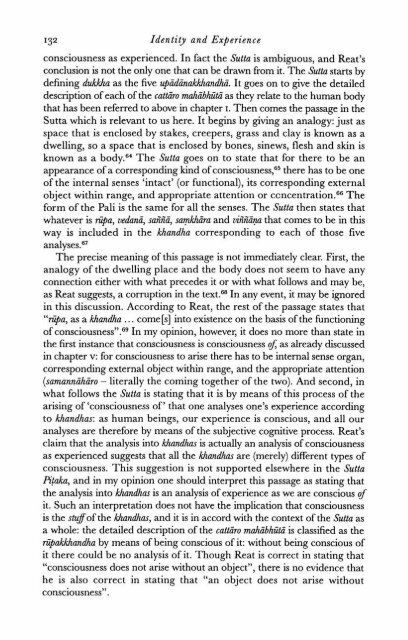Identity and Experience_Hamilton_1996
Identity and Experience_Hamilton_1996
Identity and Experience_Hamilton_1996
Create successful ePaper yourself
Turn your PDF publications into a flip-book with our unique Google optimized e-Paper software.
132 <strong>Identity</strong> <strong>and</strong> <strong>Experience</strong><br />
consciousness as experienced. In fact the Sutta is ambiguous, <strong>and</strong> Reat's<br />
conclusion is not the only one that can be drawn from it. The Sutta starts by<br />
defining dukkha as the five upidinakkh<strong>and</strong>hi. It goes on to give the detailed<br />
description of each of the catttSm fnahiibhiitd' as they relate to the human body<br />
that has been referred to above in chapter I. Then comes the passage in the<br />
Sutta which is relevant to us here. It begins by giving an analogy: just as<br />
space that is enclosed by stakes, creepers, grass <strong>and</strong> clay is known as a<br />
dwelling, so a space that is enclosed by bones, sinews, flesh <strong>and</strong> skin is<br />
known as a body.64 The Sutta goes on to state that for there to be an<br />
appearance of a corresponding kind of consciousness,65 there has to be one<br />
of the internal senses 'intact' (or functional), its corresponding external<br />
object within range, <strong>and</strong> appropriate attention or c~ncentration.~~ The<br />
form of the Pali is the same for all the senses. The Sutta then states that<br />
whatever is rips, vedanii, safifii, sapkh&a <strong>and</strong> uifiiiiy that comes to be in this<br />
way is included in the kh<strong>and</strong>ha corresponding to each of those five<br />
analy~es.~'<br />
The precise meaning of this passage is not immediately clear. First, the<br />
analogy of the dwelling place <strong>and</strong> the body does not seem to have any<br />
connection either with what precedes it or with what follows <strong>and</strong> may be,<br />
as Reat suggests, a corruption in the text.68 In any event, it may be ignored<br />
in this discussion. According to Reat, the rest of the passage states that<br />
"rripa, as a kh<strong>and</strong>ha ... come[s] into existence on the basis of the functioning<br />
of consciousness".69 In my opinion, however, it does no more than state in<br />
the first instance that consciousness is consciousness oJ; as already discussed<br />
in chapter v: for consciousness to arise there has to be internal sense organ,<br />
corresponding external object within range, <strong>and</strong> the appropriate attention<br />
(samannihiro- literally the coming together of the two). And second, in<br />
what follows the Sutta is stating that it is by means of this process of the<br />
arising of 'consciousness of' that one analyses one's experience according<br />
to kh<strong>and</strong>has: as human beings, our experience is conscious, <strong>and</strong> all our<br />
analyses are therefore by means of the subjective cognitive process. Reat's<br />
claim that the analysis into kh<strong>and</strong>has is actually an analysis of consciousness<br />
as experienced suggests that all the kh<strong>and</strong>hnr are (merely) different types of<br />
consciousness. This suggestion is not supported elsewhere in the Sutta<br />
R@ka, <strong>and</strong> in my opinion one should interpret this passage as stating that<br />
the analysis into kh<strong>and</strong>hm is an analysis of experience as we are conscious of<br />
it. Such an interpretation does not have the implication that consciousness<br />
is the stufof the kh<strong>and</strong>zm, <strong>and</strong> it is in accord with the context of the Sutta as<br />
a whole: the detailed description of the cattiZro rnahiibhzitz is classified as the<br />
riipakkh<strong>and</strong>ha by means of being conscious of it: without being conscious of<br />
it there could be no analysis of it. Though Reat is correct in stating that<br />
"consciousness does not arise without an object", there is no evidence that<br />
he is also correct in stating that "an object does not arise without<br />
consciousness".


